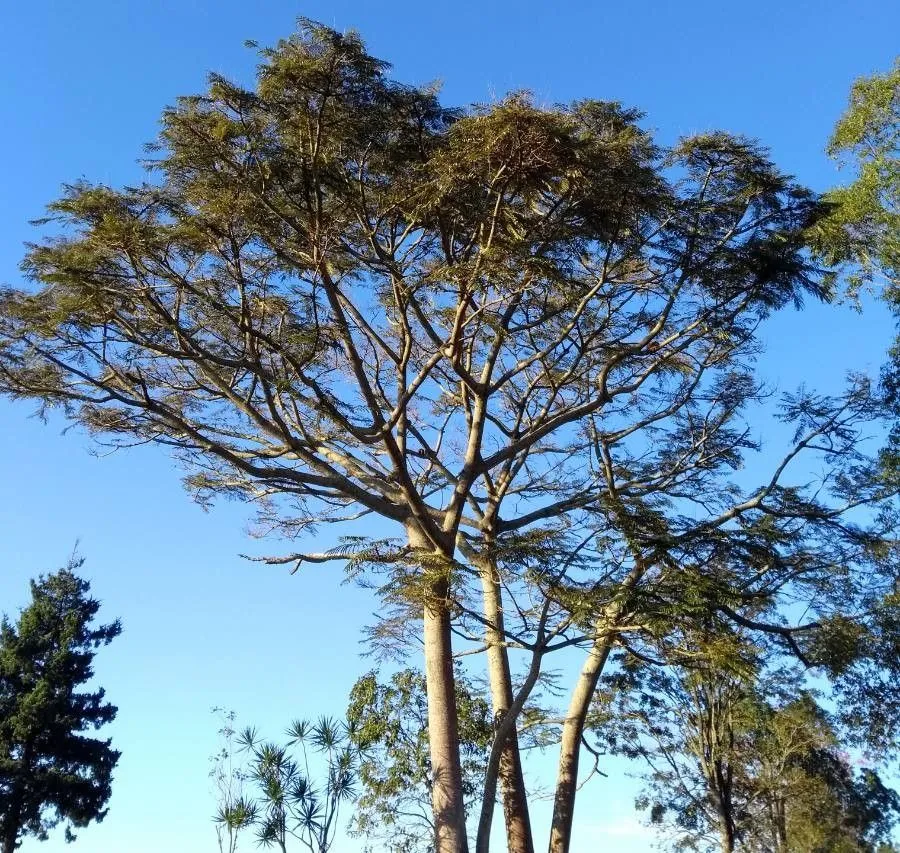
Author: Sm.
Bibliography: Spec. Bot. New Holland 4: 41 (1795)
Year: 1795
Status: accepted
Rank: species
Genus: Eucalyptus
Vegetable: False
Observations: New Guinea to E. & SE. Australia
The Queensland blue gum, scientifically known as Eucalyptus tereticornis, is a notable species within the Myrtaceae family. Described by Sm. in 1795, this tree is recognized for its distinctive characteristics and significant ecological roles across various regions.
Eucalyptus tereticornis is native to a broad geographical range, extending from New Guinea to eastern and southeastern Australia. This expansive distribution underscores the species’ adaptability and resilience in diverse environmental conditions. The tree is particularly prevalent in open forests and woodlands, thriving in well-drained soils and often becoming a dominant component of the landscape.
Characterized by its towering stature, the Queensland blue gum can reach impressive heights, making it a significant architectural feature in its natural habitat. The bark of Eucalyptus tereticornis is smooth and sheds in large plates or flakes, revealing a bluish-grey to brownish surface beneath. This shedding process not only contributes to the tree’s distinctive appearance but also plays a role in minimizing pest infestation and disease.
The leaves of the Queensland blue gum are another identifying feature. They are long, lance-shaped, and have a glossy green appearance. These leaves contain oil glands, and the tree is known for its essential oils, which have various applications, including medicinal use and as a natural insect repellent.
Ecologically, Eucalyptus tereticornis is vital for several reasons. It provides habitat and food sources for a myriad of wildlife species. Birds, insects, and mammals all rely on the tree’s flowers, seeds, and foliage. Additionally, the tree’s extensive root system helps stabilize soil and protect against erosion, making it valuable for maintaining the health of its native ecosystems.
Moreover, the Queensland blue gum plays a critical role in carbon sequestration, thus contributing to the mitigation of climate change by absorbing significant amounts of carbon dioxide from the atmosphere. Its adaptability and fast growth rate also make it a favored species for reforestation and rehabilitation projects.
In summary, Eucalyptus tereticornis or the Queensland blue gum is an essential species within its native range. Its unique biological and ecological features support a range of environmental benefits and offer significant potential for various human applications. Recognizing its importance and ensuring its conservation is crucial for maintaining the ecological balance and health of the regions it inhabits.
Eng: forest redgum, queensland blue gum, bastard-box, blue gum, blue-gum, flooded gum, flooded-gum, forest red gum, forest-red-gum, grey gum, mountain gum, red gum, red ironbark, red irongum, red-forest-gum, red-gum, red-gum-tree, red-irongum, slaty gum, slaty-gum-tree, stinking gum
Por: eucalipto, goma-vermelha-da-mata
En: Queensland blue gum, Blue gum, Forest red gum, Red gum, Red ironbark, Red irongum, Bastard-box, Mountain gum, Grey gum, Flooded gum, Stinking gum, Slaty gum, Forest redgum, Blue Fum, Blue-gum, Flooded-gum, Forest-red-gum, Red-forest-gum, Red-gum, Red-gum-tree, Red-irongum, Slaty-gum-tree, Bimble-box, Horn-cap Eucalyptus, Yukali
Af: Tereticornis bloekom
Zh: Xi ye an, 细叶桉
Fr: Eucalyptus
Pt: Eucalipto, Goma-vermelha-da-mata
© copyright of the Board of Trustees of the Royal Botanic Gardens, Kew.
© copyright of the Board of Trustees of the Royal Botanic Gardens, Kew.
Taken Apr 2, 2021 by Trap Hers (cc-by-sa)
Taken Aug 4, 2019 by Henri Cognault (cc-by-sa)
Taken May 19, 2017 by Hugo SANTACREU (cc-by-sa)
Taken Nov 10, 2022 by Kiki Kiki (cc-by-sa)
Taken Apr 29, 2020 by JP Corrêa Carvalho (cc-by-sa)
Taken Jan 1, 1900 by EOL − Jan Alam (cc-by-nc-sa)
Taken Jan 1, 1900 by EOL − Jan Alam (cc-by-nc-sa)
Taken May 19, 2017 by Hugo SANTACREU (cc-by-sa)
Taken May 19, 2017 by Hugo SANTACREU (cc-by-sa)
Taken May 19, 2017 by Hugo SANTACREU (cc-by-sa)
Taken Dec 9, 2021 by Daniel Maxwell (cc-by-sa)
Taken Aug 8, 2022 by Markus Enz (cc-by-sa)
Taken Aug 6, 2020 by Richard Picardat (cc-by-sa)
Taken Jan 1, 1900 by EOL − Forest & Kim Starr (cc-by)
Taken Jan 1, 1900 by EOL − Forest & Kim Starr (cc-by)
Growth habit: Tree
Family: Myrtaceae Author: (F.Muell.) K.D.Hill & L.A.S.Johnson Bibliography: Telopea 6: 402 (1995) Year: 1995 Status:…
Family: Rubiaceae Author: Pierre ex A.Froehner Bibliography: Notizbl. Bot. Gart. Berlin-Dahlem 1: 237 (1897) Year:…
Family: Sapindaceae Author: Koidz. Bibliography: J. Coll. Sci. Imp. Univ. Tokyo 32(1): 38 (1911) Year:…
Family: Asteraceae Author: A.Gray Bibliography: Pacif. Railr. Rep.: 107 (1857) Year: 1857 Status: accepted Rank:…
Family: Fabaceae Author: Medik. Bibliography: Vorles. Churpfälz. Phys.-Ökon. Ges. 2: 398 (1787) Year: 1787 Status:…
Family: Aspleniaceae Author: (Cav.) Alston Bibliography: Bull. Misc. Inform. Kew 1932: 309 (1932) Year: 1932…